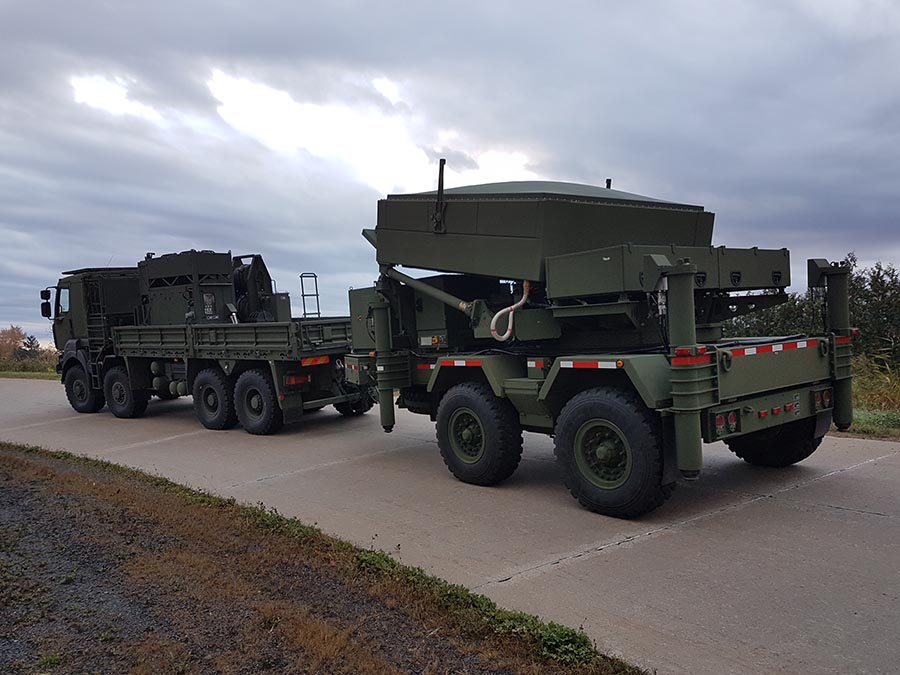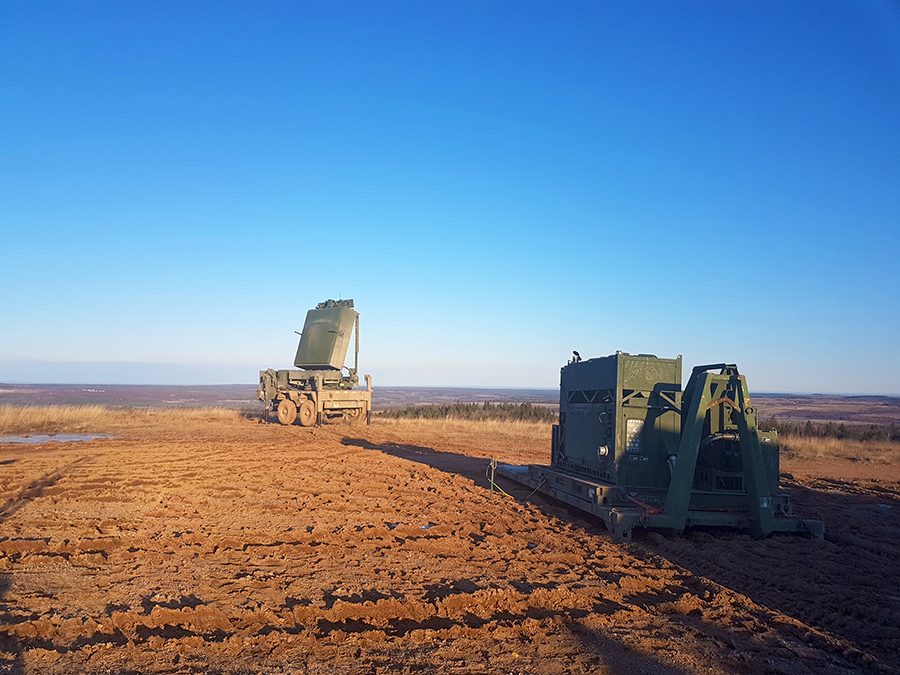by Chris Thatcher
Long-range weapon systems may be the coin of the realm as nations prepare for the prospect of peer-to-peer conflict, but recent counterinsurgency operations have demonstrated a significant threat from rockets, artillery and mortars (RAM).
Until recently, the Canadian Army owned limited options to detect and locate incoming fire from hostile projectiles.
Next fall, the Army will declare initial operating capability on a new medium range radar (MRR) able to sense and find sources of indirect fire such as artillery, mortars, rockets and other munitions and calculate their point of impact, while also providing air surveillance of hostile and friendly fixed-wing and rotary aircraft, cruise missiles and anti-radar missiles, enabling ground forces to apply countermeasures.
“We really haven’t had a radar like this in a long time,” said Major Raymond Dupuis, project director for Land Force Intelligence, Surveillance Target Acquisition and Reconnaissance (LFISTAR), a wide-ranging program begun in 2003 to deliver battlefield sensors and intelligence gathering tools that now includes small unmanned aerial systems, man-portable surveillance and target acquisition radar, and lightweight counter-mortar radar, among others.
Canada fielded the air defence anti-tank system (ADATS), an Oerlikon-built unmanned turret mounted on a M113, in the late 1980s to provide air surveillance. It featured a radar surrounded by two banks of four missiles able to engage air- and ground-based targets. But it was retired in 2012.
The MRR project began during the mission in Afghanistan as a means to deal with indirect RAM threats, but it has evolved since as technology has advanced to incorporate more capability into a single radar, Dupuis explained.
“The radar does weapon location and air surveillance. That’s not only new to Canada, that’s new for most of the world. We had a concept for weapon locating, we had a concept for air defence; we re-wrote the statement of requirements [for both]. We are looking at what changes now that we have both capabilities in one radar.”
Both the artillery and armour schools at the Combat Training Centre in Gagetown, N.B., are modifying their training plans and tactics, techniques and procedures (TTPs) to incorporate the multi-mode aspects of the Army’s various radars, said Captain Matt Becker of the director of Land Requirements.
“If you have multiple systems each capable of multiple roles, you can employ them simultaneously to do different tasks, or you can have them all dedicated to one task on the same radiating plan. That is one of the reasons they have to refine doctrine and TTPs, to determine the optimal method of employment.”
The MRR will be operated by the 4th Artillery Regiment (General Support) in Gagetown as part of a composite battery that will include the radar, the new CU172 Blackjack unmanned aerial system (UAS), the Air Space Coordination Centre (ASCC), and possibly ground-based air defence (GBAD).
“It’s worked out quite well, because we’re delivering it just as the Army is looking to acquire air defence again,” said Dupuis.
The GBAD project will provide the “shooter,” engaging targets identified by the MRR and managed through the ASCC, which is currently undergoing a modernization project to upgrade software and radios that could eventually be operated from a LAV 6, medium support vehicle system (MSVS) or a tactical operations centre.
“The radar will feed both the fire support coordination centre when there is indirect fire threats and it will also feed the ASCC, which has the local air picture,” said Becker. “This will be a key sensor for GBAD when we deliver that.”
“I think it will be a key brigade asset,” added Dupuis. “[LGen Paul Wynnyk, former Army commander] mentioned it in his farewell speech as one of the key pieces of equipment that was delivered under his command.”
Dupuis added that the ISTAR project manager, LCol Dan McKinney, and his team at Director Land Command Systems Program Management (DLCSPM), had worked wonders to acquire “key world class equipment for the Army.”

COMPOSITE BATTERY
The MRR is the ELM-2084 Multi-Mission Radar “Iron Dome,” built by ELTA Systems, a subsidiary of Israel Aerospace Industries. It is being delivered over three years by prime contractor Rheinmetall Canada under a $186.7 million contract awarded in June 2015 that includes in-service support (ISS). Rheinmetall beat out two other bidders. With ISS renewal options, the deal is valued at around $243 million.
The ELM-2084 is a three-dimensional, S-band radar with a solid-state, electronically-steered active array system designed to simultaneously or separately detect RAM at long ranges and will assist to engage large numbers of targets when integrated with a weapon system.
The Army has received the first three of 10 systems and has completed initial cadre training for both the operators and maintainers.
Operationally, the 4th Artillery Regiment’s composite batteries will employ the radars as a trio, leapfrogging one another to provide continuous coverage as the brigade moves. Each radar requires about 20 minutes to set up or take down, so while one is active, another will be dismantled as the third one takes up a new position.
“Radars give out a lot of energy,” said Becker. “They keep moving so that if they are engaged, the target is no longer there while continuing coverage at all times.”
The MRR is mounted on a trailer and can be transported by a platform like the new medium support vehicle system (MSVS) and the operator workstation – which can be up to 100 metres from the radars –could be housed in an MSVS shelter, though Dupuis cautioned the Army has yet to decide which vehicle to employ for both roles. The system is also tied to a command post, either in a vehicle or at a static location.
The MRR has faced some early media scrutiny about its compatibility with NATO allies. Dupuis noted that the system was acquired first and foremost as a brigade asset, and while direct integration with NATO is not a priority at the moment, Army assets such as this would typically be linked via a command and control node that would leave the radars under Army control.
“We want to be a good NATO partner and we believe we can link in with NATO assets if required. But our first priority was to get it in Canada, and get it employed. Then we’ll definitely be looking at those things,” he said.
Coordination centres such as the ASCC, Fire Support Coordination Centre (FSCC), and Surveillance and Target Acquisition Coordination Centre (STACC) are often networked with NATO through tactical data links like Link 16, Becker noted.
With new radars and unmanned systems entering service now and modernized ground-based air defence, airspace coordination and ISR on the horizon, there’s a palpable excitement across the 4th Artillery Regiment, said Becker, adding they are working hard to field all this new capability.
“It has been a while since they have had this level of capability. They used to have ADATS, they used to have the ScanEagle (UAV). So they are excited to get back into the business of force generating and using this kit.”

